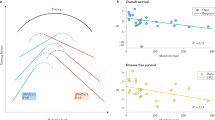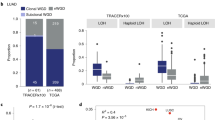Abstract
Microsatellite (MS) mutations can potentially unravel the past of mutator phenotype tumors, with greater genetic diversity expected in older regions. Rapid clonal expansions of xenografts were characterized by relatively homogenous MS alleles, whereas greater diversity was observed in a colorectal cancer with the greatest variation in its adjacent adenoma. A subcutaneous lung cancer metastasis demonstrated diversity consistent with its one–month clinical duration and evidence of active mitosis during dormancy. The genetic legacy inherent to multistep tumorigenesis provides direct estimates of tumor ages, with up to thousands of cell divisions and high death rates necessary to yield the observed diversities. MS molecular tumor clocks have the unique potential to systematically reconstruct the early and occult evolution of individual human mutator phenotype tumors.
This is a preview of subscription content, access via your institution
Access options
Subscribe to this journal
Receive 12 print issues and online access
$209.00 per year
only $17.42 per issue
Buy this article
- Purchase on Springer Link
- Instant access to full article PDF
Prices may be subject to local taxes which are calculated during checkout
Similar content being viewed by others
References
Nowell, P.C. The clonal evolution of tumor cell populations. Science 194, 23–29 (1976).
Welin, S., Youker, J. & Spratt, J.R., Jr. The rates and patterns of growth of 375 tumors of the large intestine and rectum observed serially by double contrast enema study (Malmo technique). Am. J. Roentgenol. 90, 673–687 (1963).
Zuckerkande, E. & Pauling, L. Evolutionary divergence and convergence in proteins, in Evolving Genes and Proteins. (eds. Bryson, V. & Vogel, HJ.) 97–106 (Academic Press, New York, 1965).
Ionov, Y., Peinado, M.A., Malkhosyan, S., Shibata, D. & Perucho, M. Ubiquitous somatic mutations in simple repeated sequences reveal a new mechanism for colonic carcinogenesis. Nature 363, 558–561 (1993).
Aaltonen, L.A. et al. Clues to the pathogenesis of familial colorectal cancer. Science 260, 812–816 (1993).
Thibodeau, S.N., Bren, G. & Schaid, D. Microsatellite instability in cancer of the proximal colon. Science 260, 816–819 (1993).
Loeb, L.A. Mutator phenotype may be required for multistage carcinogenesis. Cancer Res. 51, 3075–3079 (1991).
Shibata, D., Peinado, M.A. Ionov, Y., Malkhosyan, S. & Perucho, M. Genomic instability in repeated sequences is an early somatic event in colorectal tumorigenesis that persists after transformation. Nature Genet. 6, 273–281 (1994).
Bhattacharyya, N.P., Skandalis, A., Ganesh, A., Groden, J. & Meuth, M. Mutator phenotypes of human colorectal carcinoma cell lines. Proc. Natl. Acad. Sci. USA 91, 6319–6323 (1994).
Weber, J.L. & Wong, C. Mutation of human short tandem repeats. Hum. Mol. Genet. 2, 1123–1128 (1993).
Kimura, M. & Ohta, T. Stepwise mutation model and distribution of allelic frequencies in a finite population. Proc. Natl. Acad. Sci. USA 75, 2868–2872 (1978).
Valdes, A.M., Slatkin, M. & Freimer, N.B. Allele frequencies at microsatellite loci: The Stepwise mutation model revisited. Genetics 133, 737–749 (1993).
Bowcock, A.M. et al. High resolution of human evolutionary trees with polymorphic microsatellites. Nature 368, 455–457 (1994).
Di Rienzo, A. et al. Mutational processes of simple-sequence repeat loci in human populations. Proc. Natl. Acad. Sci. USA 91, 3166–3170 (1994).
Goldstein, D.B., Linares, A.R., Cavalli-Sforza, L.L. & Feldman, M.W. Genetic absolute dating based on microsatellites and the origin of modern humans. Proc. Natl. Acad. Sci. USA 92, 6723–6727 (1995).
Goldstein, D.B., Linares, A.R., Cavalli-Sforza, L.L. & Feldman, M.W. An evaluation of genetic distances for use with microsatellite loci. Genetics 139, 463–471 (1995).
Slatkin, M. A measure of population subdivision based on microsatellite allele frequencies. Genetics 139, 457–462 (1995).
Steel, G.G. Cell loss as a factor in the growth rate of human tumors. Eur. J. Cancer 3, 381–387 (1967).
Steel, G.G. Growth Kinetics of Tumors. 185–216 (Clarendon, Oxford, 1977).
Wheelock, E.F., Weinhold, K.J. & Levich, J. The tumor dormant state. Adv. Cancer Res. 34, 107–140 (1981).
Holmgren, L., O'Reilly, M.S. & Folkman, J. Dormancy of micrometastases: Balanced proliferation and apoptosis in the presence of angiogenesis suppression. Nature Med. 1, 149–153 (1995).
Fearon, E.R. & Vogelstein, B. A genetic model for colorectal tumorigenesis. Cell 61, 759–67 (1990).
Strauss, M., Lukas, J. & Bartek, J. Unrestricted cell cycling and cancer. Nature Med. 1, 1245–1246 (1995).
Papadopoulos, N. et al. Mutation of a mutL homolog in hereditary colon cancer. Science 263, 1625–1629 (1994).
Umar, A. et al. Defective mismatch repair in extracts of colorectal and endometrial cancer cell lines exhibiting microsatellite instability. J. Biol. Chem. 269, 14367–14370 (1994).
Nyström-Lahti, M. et al. Founding mutations and Alu-mediated recombination in hereditary colon cancer. Nature Med. 1, 1203–1206 (1995).
Shibata, D. et al. Specific genetic analysis of microscopic tissue after selective ultraviolet radiation fractionation and the polymerase chain reaction. Am. J. Pathol. 141, 539–543 (1992).
Hauge, X.Y. & Litt, M. A study of the origin of shadow bands seen when typing dinucleotide repeat polymorphisms by the PCR. Hum. Mol. Genet. 2, 411–415 (1993).
Manoukian, E.B. Modern Concepts and Theorems of Mathematical Statistics. 126 (Springer-Verlag, New York, 1986).
Levinson, G. & Gutman, G.A. High frequency of short frameshifts in poly-CA/GT tandem repeats borne by bacteriophage M13 in Escherichia coli K-12. Nucleic Acids Res. 15, 5322–5338 (1987).
Author information
Authors and Affiliations
Rights and permissions
About this article
Cite this article
Shibata, D., Navidi, W., Salovaara, R. et al. Somatic microsatellite mutations as molecular tumor clocks. Nat Med 2, 676–681 (1996). https://doi.org/10.1038/nm0696-676
Received:
Accepted:
Issue Date:
DOI: https://doi.org/10.1038/nm0696-676
This article is cited by
-
Sample path properties of the average generation of a Bellman–Harris process
Journal of Mathematical Biology (2019)
-
Building a lineage from single cells: genetic techniques for cell lineage tracking
Nature Reviews Genetics (2017)
-
Inferring average generation via division-linked labeling
Journal of Mathematical Biology (2016)
-
Using tumour phylogenetics to identify the roots of metastasis in humans
Nature Reviews Clinical Oncology (2015)
-
Human cancers express mutator phenotypes: origin, consequences and targeting
Nature Reviews Cancer (2011)



